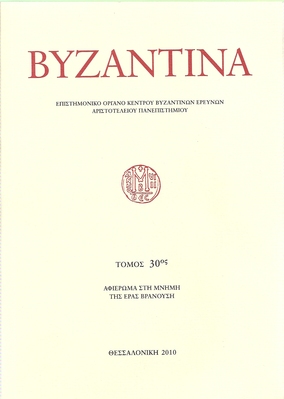Η "αοίκητος" Λάρισα και η αναστήλωση του καθεδρικού ναού του αρχάγγελου Μιχαήλ Τρικάλων (c.1332, 1362) : βιβλικά αρχέτυπα και ιστορικά αντίτυπα
Part of : Βυζαντινά : επιστημονικόν όργανον Κέντρου Βυζαντινών Ερευνών Φιλοσοφικής Σχολής Αριστοτελείου Πανεπιστημίου ; Vol.29, No.1, 2009, pages 163-198
Issue:
Pages:
163-198
Parallel Title:
The "aninhabited" Larissa and the restoration of the archangel's Michael cathedral, Trikala (c.1332, 1362) : biblical archetypal and historical antitypal
Author:
Abstract:
After 1318 the archbishops of Larissa Kyprianos (1318-1332) and Antonios (1332/1333-1363+) had settled their residence in Trikala. Both restored and inaugurated the Archangel Michael’s Cathedral being there, the former about 1332, after a fire disaster of the Church and the whole town, and the latter in 1362, when he delivered an encomion in honour of his predecessor saint Kyprianos (his memory was honoured probably between 3 May and 6 August). In this text, beyond the events of the life of Saint Kyprianos or his own biographical, Antonios essentially narrated about the Larissa’s metropolis life during the last 50 years (1313/1318- 1362). The author’s originality is in the fact that he selects a serial of «parallel» events, both, between him and his predecessor, and between them and the biblical history; that is the revolution of the Maccabees and the dedication of the Temple of Jerusalem (167-163 B.C.) (Book of Maccabee's I-Π). By a way, the biblical archetypal is revived again in the life of the two metropolitans and in the historical life of the Metropolis of Larissa.The tragic destiny of Jerusalem, captured by Antiochos IV. persecuting and turning out its inhabitants, but non devastating this town, has several common elements with the «aninhabited» (αοίκητος) Larissa. This, points out that the author doesn’t speak literal, but he transports a symbolical (typological) interpretation: Larissa had lost the greater number of its inhabitants, it was indeed «αοίκητος», aninhabited, but simply by the people of God. and not completely abandoned. The inhabitants, firstly the shepherds and secondly other people, left the town and its environs, but some townspeople were lived yet, like the Sciptures’ «bandits», and were trading on the Cathedral of Saint Achillios and the people of the rest area (περιόντες) (1318-1333). Although the byzantine troops were coming in Thessaly (1333), the whole territory of the plain of Larissa (not including other areas of eastern Thessaly, like Vessaina, Lycostomion-Platamon, etc), never developed again, and so later passed under the control of the first Turks nomads (1387).
Notes:
Το άρθρο περιέχεται στο αφιέρωμα στη μνήμη του Δημητρίου Γ. Τσάμη




